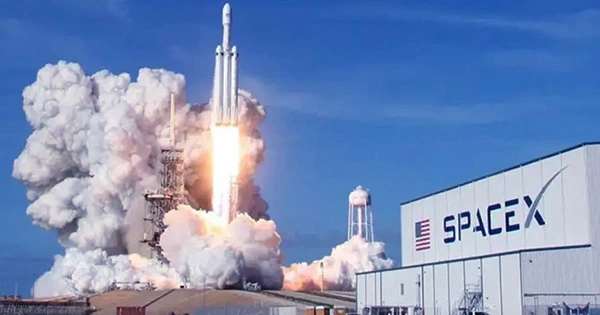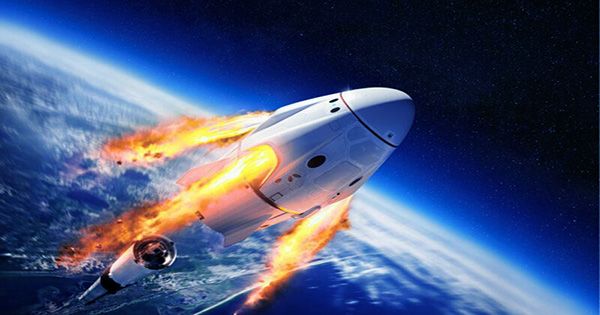Elon Musk, CEO of SpaceX, expressed optimism that Starship will survive its second mission attempt.
In a keynote lecture on Thursday (Oct. 5) at the International Astronautical Congress (IAC) in Baku, Azerbaijan, Elon Musk discussed Starship, a massive SpaceX reusable rocket system aiming for a new near-orbital mission in the near future.
Musk remarked in a video interview with moderator and Voyager Space chief revenue officer Clay Mowry that SpaceX did not want to “set expectations too high” following an explosive orbital attempt in April. Among other problems, the two stages of Starship failed to separate; SpaceX eventually exploded the vehicle high above the Gulf of Mexico on purpose. Musk, 52, eventually aims to use Starship to transport people to the moon and Mars, continuing his decades-long objective with SpaceX, which he founded in 2002.
Starship and its Super Heavy booster are the most powerful rocket systems ever built, with nearly double the liftoff thrust of NASA’s Space Launch System (SLS) rocket intended for the Artemis program; until Starship is ready for operational flights, SLS is the most powerful launcher currently in service.

However, a significant contract deadline is approaching: NASA has tasked Starship with landing the Artemis 3 crew on the moon in 2025 or 2026, the first such attempt by humans since Apollo 17 in 1972.
Delays in getting Starship ready in recent months prompted NASA officials to repeatedly state that they are monitoring SpaceX’s efforts. In early August, Jim Free, the agency’s associate administrator of the exploration systems development mission directorate, stated that SpaceX still has time to meet NASA’s Artemis 3 standards. But, if not, the agency is willing to undertake a non-landing mission for Artemis 3 and postpone the lunar landing until at least Artemis 4.
We have no idea when Starship will fly again. Musk said that the system would be ready for a new mission in “six to eight weeks” in early May. This summer, his company also performed theatrical Starship engine fires in preparation for the upcoming flight. However, the US Federal Aviation Administration (FAA) warned in late September that the necessary regulatory processes for dealing with concerns on the first flight were not yet complete.
While SpaceX stated that it has completed its investigation and done all 57 actions required for the next flight, the FAA has yet to grant a license for the second launch. According to Reuters, SpaceX must also obtain environmental certification from the United States Fish and Wildlife Service. However, once these critical concerns are addressed, SpaceX is expected to launch shortly. Musk has also stated that Starship is technically ready to launch.
Flight 2, as Musk refers to the impending Starship launch, will contain major upgrades to Starship that SpaceX has just implemented. For example, Starship intends to “hot stage” the system, which means that the second-stage engines will be lit before the vehicle’s two stages have entirely separated.
While the Soviet Union used hot staging before, Musk claims this is the first time SpaceX will use it. “I’d say that’s the riskiest part of the flight,” he went on to explain. “If the engines light and the ship doesn’t blow itself up during staging, then I think we’ve got a decent chance of reaching orbit.”
If all goes as planned, Starship will perform a partial orbit of Earth before splashing down in the Pacific off the coast of Hawaii, he said. The heat shield, which has yet to be tested in flight, will be the next critical test.
“We think it will work, but we’re not sure,” Musk said of the heat shield. “So if it doesn’t work, we want it to not work over the Pacific — which is a large body of water with almost no people on it.”
According to Musk, the current version of Starship produces roughly twice the thrust of the powerful NASA Saturn V rocket that delivered Apollo men to the moon in the 1960s and 1970s. “With the upgrades that we have in the works, it’ll do about three times the thrust,” he went on to say. Starship now produces 16 million pounds of thrust at liftoff, with SpaceX aiming for 20 million pounds in the near future, following subsequent engine enhancements.
Reusability will bring about more improvements, according to Musk. Depending on when permits are obtained, launch tower changes to the access arms to snag the returning Super Heavy booster’s first stage mid-flight could be available “within the next year, or maybe less than a year.”
“If we get lucky, we might catch the ship towards the end of next year,” Musk said of the Starship.
Musk’s intended crew destination: Mars, is supported by the “absurd size” of the 394-foot-tall (120-meter) Starship and Super Heavy stack. The goal is to “create something capable of establishing a permanent base on the moon and a city on Mars.” That’s why it’s so big. Otherwise, we can make it a lot smaller,” he explained.
Musk hopes to land on Mars without a crew “within the next four years,” though he emphasized that the goal is only “sort of feasible.” There’s more to come: Starship’s propulsion technology “should, to generalize, be able to land anywhere on a solid surface anywhere in the solar system,” Musk added.
Dust would be one of the most difficult hurdles for a moon landing, but presuming Starship can handle it, just “minor modifications” would be necessary for destinations such as Mars, the asteroid belt, and Jupiter’s and Saturn’s cold moons, Musk said. He went on to say that these far-flung locations may house propellant plants to power future space travel, utilizing resources like water ice.
The business is also trying to reuse as many other components of its space systems as possible, such as employing its Earth-orbiting broadband satellite Starlink system for laser communications at Mars and recycling portions of the SpaceX spacesuit used for astronaut missions.
The spacesuit is currently only used for spacecraft interiors, but upgrades (which Musk did not specify) will allow for an extravehicular activity or spacewalk outside Starship during the Polaris Dawn mission, the first of three flights in billionaire Jared Isaacman’s self-directed space program. (In addition to Inspiration4, which he and three others flew on SpaceX’s Falcon 9 and Crew Dragon in 2021, Isaacman is funding these flights.)
Then there are lunar rovers, which may be converted from Tesla automobiles, Musk’s car company. “The nice thing about electric cars is that they obviously do not require oxygen,” added Musk, who also serves as Tesla’s creator and CEO. “I believe Tesla could easily produce a car, such as a Cybertruck ‘luna variant.'” Simply purchase the IP [intellectual property] or the’moon option’ package,” he explained.
SpaceX will generate revenue for Starship development through its other missions, which include periodic Starlink launches (version 3 is expected next year), International Space Station launches of astronauts and cargo, satellite launches for customers such as the United States Space Force, and (Musk disclosed) an approximately 26-foot (8 m) space telescope for the University of California, Berkeley, which may use Starship.
This revenue does not include additional crewed Starship launches in the future. Isaacman intends to use Starship to complete his three-mission Polaris Program, while other billionaires and space tourists such as Yusaku Maezawa and Dennis Tito intend to use the system for other lunar endeavors.
Musk intends to execute frequent Starship sorties from both south Texas and SpaceX’s leased Launch Pad 39A at NASA’s Kennedy Space Center in Florida, where Crew Dragon launches are already taking place. He anticipated that within four or five years, SpaceX might have a “greenfield location” for Starship at neighboring Cape Canaveral (where it presently launches its Falcon 9 and Falcon Heavy rockets) capable of launching numerous times per day.
“If you’re launching 10 times a day, we might need to go to an ocean-based platform.” “That might be a bit much even for the Cape,” he continued. “However, we might end up doing platform-based launches from a specially designed oceangoing platform.” However, we will need to conduct numerous launches. Every year, thousands of launches take place.”
Musk stated that the amazing launch rate would be required to transport over 100,000 tons of cargo to orbit every year, which he stated is “still not quite enough” for his Mars expedition goals, which would require “roughly a million tons” per year.
(For perspective, the workhorse Falcon 9 rocket carries about 1,500 to 1,600 tons to orbit per year, which Musk estimated is roughly 80% of Earth’s yearly launching mass to space. He plans to increase that to 2,500 tons next year.) “Either we do that, or we’re a single-planet species forever,” Musk told reporters. “We achieve those kinds of numbers, or we will never have a self-sustaining city on Mars.”
Those who remain on Earth may be able to use Starship in other ways, Musk indicated, such as a quick means to move people or freight between continents on our planet, which he suggested may be cost-effective due to Starship’s use of low-cost liquid methane propellant. Further cost reductions may be gained by eliminating pilots (since the system would be self-driving) and even items like restrooms, given that passengers would only need half an hour on board to reach their destination.
“It really comes down to whether it is economically viable in comparison to long-distance aircraft.” And I believe our back-of-the-envelope calculations indicate that it has a chance,” he said.













